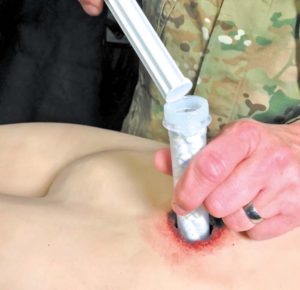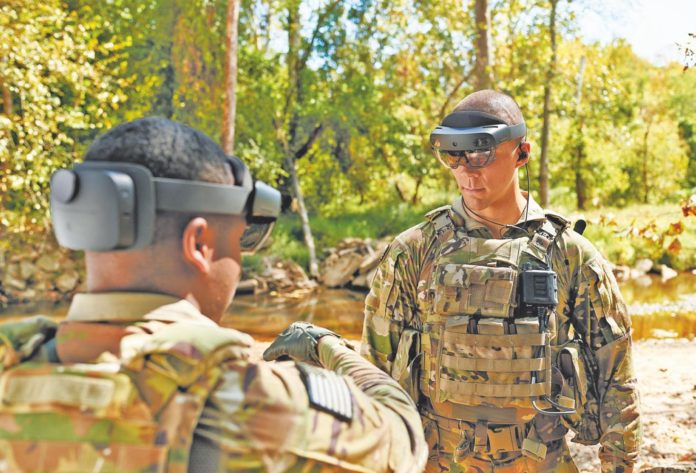Military scientists are forever expanding the boundaries of their research in science & technology to support the military forces to maintain technological superiority in warfighting equipment. Technological superiority underpins national military strategy, allowing the armed forces to field the most potent military forces by making best use of resources, both economic and human.
Enhancing human resources has taken many new forms. All human sensors are being exploited to their maximum capabilities and then solutions are being found to augment them with technology.
Next-Generation Nonsurgical Neurotechnology Programme
The US Pentagon is trying build tech that would give soldiers the ability to control deadly military drones with their minds. Working with drones and swarms of drones, operating at the speed of thought rather than through mechanical devices – those types of things are what these devices are really for,’ according to DARPA.
The Next-Generation Nonsurgical Neurotechnology (N3) programme aims to develop high-performance, bi-directional brain-machine interfaces for able-bodied service members. Such interfaces would be enabling technology for diverse national security applications such as control of unmanned aerial vehicles and active cyber defense systems or teaming with computer systems to successfully multitask during complex military missions.
Whereas the most effective, state-of-the-art neural interfaces require surgery to implant electrodes into the brain, N3 technology would not require surgery and would be man-portable, thus making the technology accessible to a far wider population of potential users. Noninvasive neurotechnologies such as the electro-encephalogram and transcranial direct current stimulation already exist, but do not offer the precision, signal resolution, and portability required for advanced applications by people working in real-world settings.
To enable future non-invasive brain-machine interfaces, N3 researchers are working to develop solutions that address challenges such as the physics of scattering and weakening of signals as they pass through skin, skull, and brain tissue, as well as designing algorithms for decoding and encoding neural signals that are represented by other modalities such as light, acoustic, or electro-magnetic energy.
Integrated Visual Augmentation System
No other piece of equipment has had this kind of impact since the introduction of night vision. The US military is developing augmented reality night vision goggles.
A Microsoft-designed prototype goggle – the Integrated Visual Augmentation System (IVAS), that offers the capabilities they need to regain and maintain overmatch in multi-domain operations on battlefields that are increasingly urban, congested, dark and unpredictable – has been tested in November 2019.
The IVAS prototype, based on Microsoft’s heads up display, was designed using Microsoft’s HoloLens 2. That first STP was geared toward proving concept and utility.
The final product will include a variety of features: a color see-through digital display that makes it possible for the user to access information without taking his eye off the battlefield; thermal and low-light sensors that make it possible to see in the dark, literally; rapid target acquisition and aided target identification; augmented reality and artificial intelligence, to name just a few. IVAS is billed as a fight-rehearse-train system, meaning its function on the battlefield is priority, but its augmented reality capabilities, like real-time mapping, will make it useful for training and rehearsing operations anywhere at any time.
Xstat – Rapid Hemostasis System
The Rapid Hemostasis System or Xstat is a revolutionary technique to stop excessive blood loss due to injuries on the battlefield. Generally, a simple tourniquet is used in these circumstances, which are successful most of the times. But a US based medical firm has come up with an efficient way to stop blood loss completely.

The technique includes an injector syringe and tablets lookalike sponges that inflate when comes in contact with the wound. These sponges are actively covered by hemostatic (blood stopping) agent. Evidently, the wound can be completely filled with inflated sponges in less than fifteen seconds, allowing hemostasis to kick in and completely stopping the blood loss.
Electronic Drug Prescriptions
What if instead of pills or injections doctors could prescribe electronics? DARPA’s Electrical Prescriptions (ElectRx) program is a blanket program for a diverse range of research being conducted in using electrical stimulation of the peripheral nerves to treat conditions such as chronic pain, inflammation, and PTSD. The idea itself isn’t entirely new – pacemakers have been around for a while and neurostimulators are already providing treatment for neurological conditions like Parkinson’s. Another team is examining the potential of nerve stimulation to treat PTSD. The researchers believe that nerve stimulation could be used to regulate neurochemical responses and reduce fear and anxiety in PTSD patients.
Augmented Reality
Contact Lenses
DARPA is reportedly interested in a smart contact lens that could give soldiers superpowers by augmenting troops’ visual capabilities in the field, meaning the gadget could represent the augmented contact lens that DARPA has spent a decade searching for.

Placing that information on a screen that’s always in front of you – like a contact lens directly in front of your eyeball – means that you don’t have to stop what you’re doing to look something up. And the minute you’ve got what you need, that information disappears.
Instant Language Translation
Imagine a handheld device that can translate any language in real time, like having a translator at your disposal at all times. DARPA’s Broad Operational Language Translation (BOLT) program is aiming to do just that. The technology can be deployed on an Android device. An English-speaker can say a phrase and the device can repeat it back in another language, and vice versa. The system currently only works with Iraqi Arabic, but DARPA says it can easily be expanded to others in the future.
Next-Level Prosthetics
DARPA invested a $7 million in the DEKA Arm, created by Segway inventor Dean Kamen, also known as the Luke Arm (after Luke Skywalker) the prosthetic is dexterous enough to handle objects as delicate as a grape. Amputees will finally get prosthetics that are as advanced as the ones we see in science fiction. DARPA’s Revolutionizing Prosthetics program has been working on the problem since 2006 and has announced some promising developments over the years.
Meanwhile, researchers at Johns Hopkins University’s Applied Physics Lab have developed a bionic hand can actually provide its wearer with a sense of touch via electrodes that connect to the patient’s sensory and motor cortexes. The neural connection also allows patients to control the arm using only their thoughts. The ultimate goal is to someday provide injured soldiers with prostheses advanced enough to allow them to return to the battlefield, if desired.
Other Projects
Artificial Muscles. Made from plastic Future Army robots will be the strongest in the world, if visionary researchers have their way. Robots could be armed with artificial muscles made from plastic. Army and academic researchers collaborated to study how plastic fibers respond when they are twisted and coiled into a spring. Different stimuli causes the spring to contract and expand, mimicking natural muscles. Artificial muscles could potentially augment robot performance, allowing our future mechanical partners to buff up, and pump.
Monitoring Soldier Health. With biorecogni-tion receptors Army and academic researchers are looking at how to monitor Soldier health and performance in real-time, by developing unique receptors. Future bioreceptors will be small, simple to produce, inexpensive, and robust to environmental stresses.
Human Interest Detector. US Army researchers have developed a human interest detector that can determine where people are looking and decode their brain activity. By monitoring brainwaves, researchers track neural responses and assess what captures a Soldier’s attention among a myriad of stimuli in threat environments.
Soldier-robot Teams. Army researchers have been developing new algorithms and capabilities that are unseen in industry – enabling autonomous agents such as robots to operate in these unknown environments such as future battlefields.


















